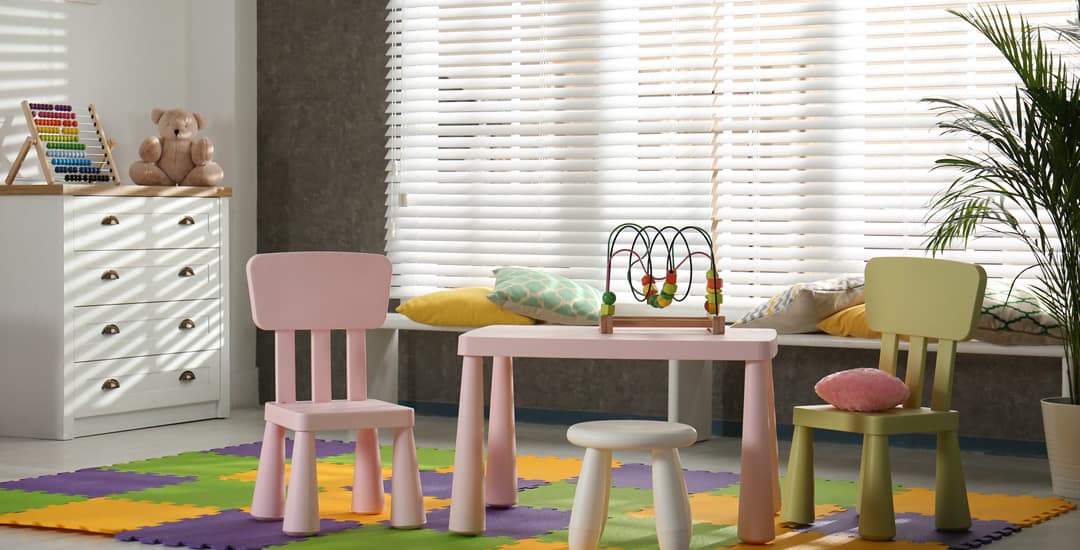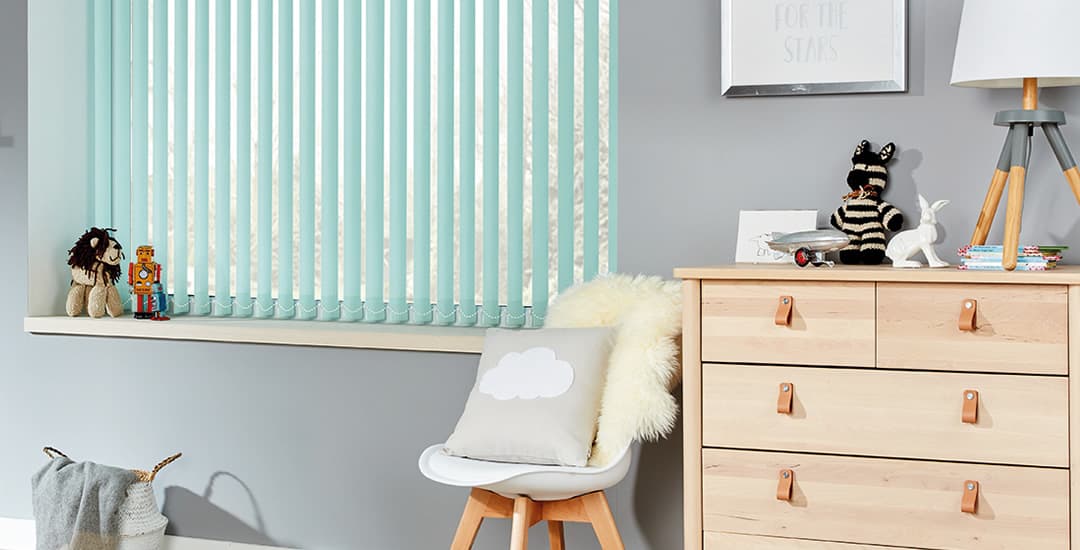
What blinds are best for a playroom? I have three equally accurate answers to this, which are:
- Blinds kept far out of the reach of the children in said playroom.
- Very cheap and so ultimately, sacrificial blinds.
- Hardwearing and waterproof blinds.
As the first two options are fairly unrealistic, I’m going to concentrate on option three; blinds that are both hardwearing and also waterproof.
The main challenges that playroom blinds are likely to face tend to involve some combination of common assault and water (or other liquids – paints, maybe glue, snot perhaps? Even blood if the sibling rivalries in your manor are a bit Game of Thrones), and so some blinds are a far better choice than others.
In this blog post I’ll make some suggestions of the best blinds for a child’s playroom, plus tell you what playroom blinds to avoid at all costs. On the flipside, I’ll also advise on what blinds are safe for use around children, should the hunter happen to become the hunted…
What are the best blinds for a playroom?
Judged against the benchmark that playroom blinds need to be both waterproof and hardwearing, I have two contenders for the very best blinds for a playroom, each for slightly different reasons.
The best blinds for a child’s playroom are faux-wood blinds, and waterproof roller blinds respectively.
Faux-wood blinds are made of thick, rigid PVC, which makes them the toughest and most hardwearing type of blinds overall when it comes to rough and tumble, and being set upon by the odd plastic sword. They’re also totally waterproof, which means not only will they not die of Spillage or Throwage, but that they’re also very easy to clean if and when said Spillage or Throwage occurs.
Waterproof roller blinds (which means roller blinds made of either PVC or vinyl) are also a sound choice of blinds for a kid’s playroom.
The whole waterproof side of things applies in the same way as it does with faux-wood blinds; and waterproof roller blinds won’t give up the ghost if set upon with child-safe scissors, nor beaten about with bare hands or moderately sturdy objects.
Realistically, waterproof roller blinds are not quite as hardwearing as faux-wood blinds, and could become damaged if really pulled about enough to snag the fabric or damage the working mechanisms.
In their favour as playroom blinds they’re also the most economical choice of window blinds overall, which might well be what you’re looking for when choosing blinds for a room you’re pretty much writing off as in need of immediate redecoration when your kids are old enough to be thinking about buying blinds of their own.
What playroom blinds are a bad idea?
Blinds to avoid when it comes to shopping for a playroom would be:
- Roman blinds (expensive, not waterproof, sometimes made of delicate fabrics).
- Real wood blinds (moderately expensive, not waterproof, made of real wood and so, susceptible to deliberately inflicted damage).
- Day and night blinds (also moderately expensive, not waterproof, and the sheer parts of the fabric are fine and delicate).
- Non-waterproof variants of roller blinds and vertical blinds are a poor choice too.
“My kids can be trusted” blinds for a playroom

I do also have two types of blinds that are neither here nor there in terms of being firmly ruled in or out for a kid’s playroom; these are waterproof vertical blinds, and aluminium Venetian blinds respectively.
These blinds are potentially viable options if your children are older and/or more or less trustworthy; such blinds will withstand more or less any accidental threat like something being spilled or splattered on them, but they do not make for good punch bags.
Aluminium Venetian blinds are waterproof, and can be wiped clean; but their slats are very narrow and numerous and this can make cleaning them fiddly. Also, if they’re bashed about a lot or forced to be the boundary ropes of a wrestling ring, their slats can dent out of shape, and the paint may chip too.
Waterproof vertical blinds are also fine in the splash ‘n’ spill stakes, but their numerous louvres are not good with being pulled on, nor will the connecting chains and weighs at the bottom of them fare well with this sort of treatment either.
What type of blinds are child safe?
Thus far, I’ve covered the basics of what blinds are most likely to survive your children; shoe on the other foot then, which blinds are unlikely to herald the untimely demise of your child?
Any of the above-mentioned options, including those that come with grave warnings on why they are best kept out of playrooms for the sake of the blind rather than the child, are safe for use around children.
All window blinds sold in the UK/sold to the UK market have to conform to strict child safety regulations, which are largely concerned with ensuring that children cannot hang or strangle themselves on control cords or other functional elements.
Fitting the blind you buy in accordance with the directions supplied with it, including the use of any relevant safety devices, is absolutely integral to ensuring that your blinds are child-safe; but there are no “unsafe” blinds for children in and of themselves when it comes to blinds sold legally in the UK.




